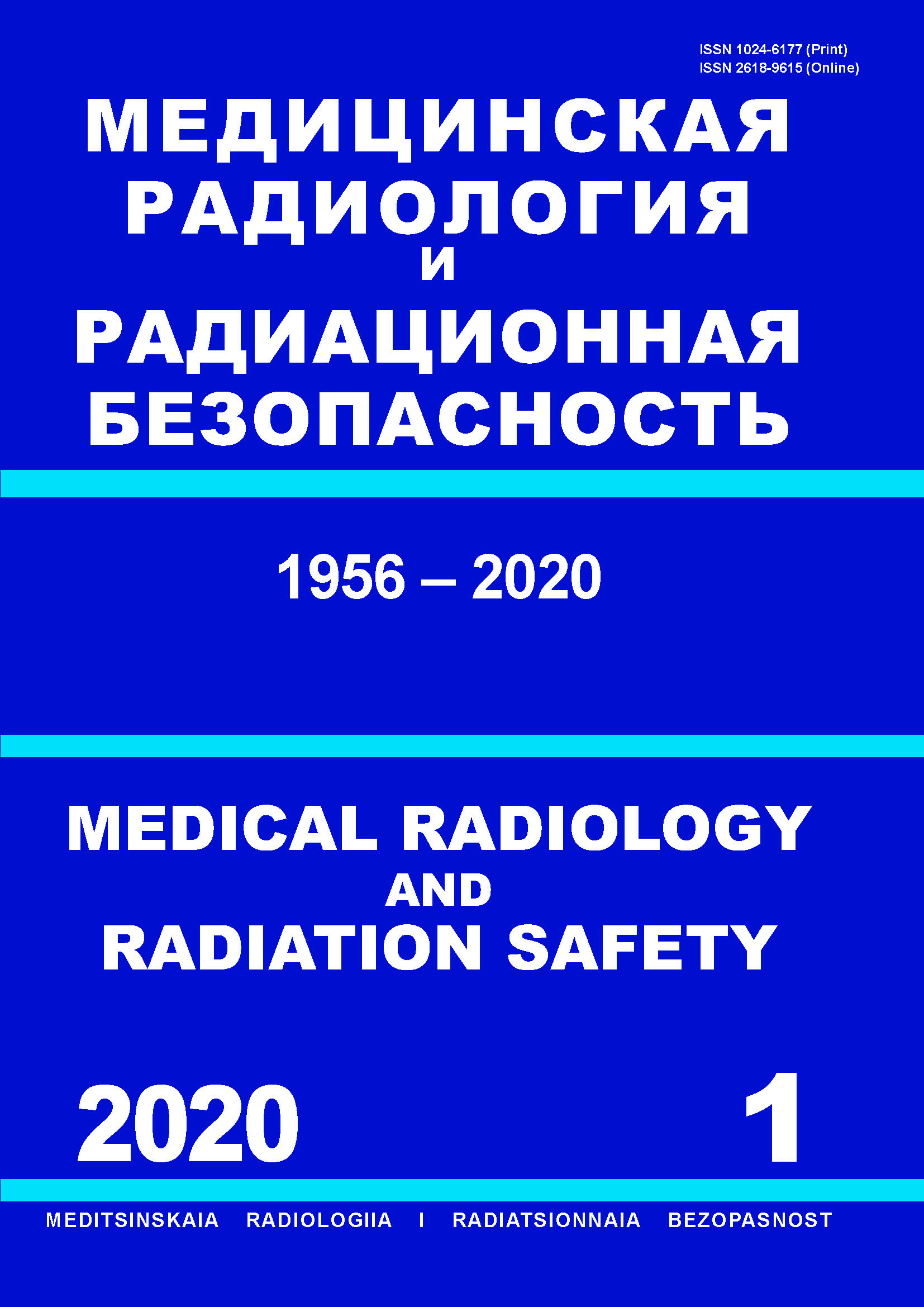Tomsk, Russian Federation
National Research Tomsk Polytechnic University (Deputy Director)
Tomsk, Russian Federation
Shemyakin & Ovchinnikov Institute of Bioorganic Chemistry, Russian Academy of Sciences, Moscow (Head of Laboratory)
Tomsk, Russian Federation
Tomsk, Russian Federation
Tomsk, Russian Federation
76.03
76.33
14.04.02
31.06.2001
31.08.08
32.08.12
51
534
5708
5712
5734
6212
Purpose: Evaluation of a radiopharmaceutical based on 99mTc-labeled targeted molecules DARPin9_29 for radionuclide diagnostics of malignancies with Her2/neu overexpression. Material and methods: The DARPin9_29 sequence was amplified from the plasmid pET-DARP-6HIS for the DARPin9_29-His6 gene expression in E. coli cells. The eluent of 99mTcO4– (400–500 μl, 4 GBq) was added to the kit and incubated at a temperature of 100 °C for 20 minutes. After incubation, 40 μl of tricarbonyl technetium was added to 168 μg of DARPin9_29 in 100 μl of PBS (sodium phosphate buffer), followed by incubation at 40 °C for 60 minutes. The radiochemical yield and purity were determined by thin layer radiochromatography, the purification was performed using NAP-5 cleansing columns (GE Healthcare). Cell lines with different levels of Her2/neu expression were used: SKOV-3> BT474 >> DU-145 for the determination of the radiopharmaceutical specificity. Her2/neu expressing cell line SKOV-3 was used for in vitro study. The study was conducted 6 hours after the administration of the drug. Results: The radiochemical yield was 72 ± 8 %, the radiochemical purity after purification was 98.7 ± 1.0 %. The stability in PBS (phosphate buffered saline) solution after 1 hour was 99.8 ± 0.2; after 3 hours – 98.2 ± 0.1. In vitro studies showed that the accumulation of explored compound was directly proportional to the level of Her2/neu expression in cells, while blocking the receptors with an excess of unlabeled protein showed a significant reduction in binding in the group of cells. Data on biodistribution and SPECT/CT in the body of the animal BALB/c nu/nu demonstrated rapid removal of the compound from the blood stream and high accumulation in the liver, kidney and bladder 6 hours after the introduction of the radiopharmaceutical. Conclusion: The studies demonstrated high radiochemical yields and purity, as well as stability of the studied compound. The results of in vitro and in vivo analysis showed the specificity and affinity of the radiopharmaceutical to the Her2/neu receptor on the surface of tumor cells. The high accumulation of the drug in the liver and kidneys, detected in in vivo studies, is probably due to the lipophilicity of the 99mTc(CO)3-histidine tag and indicates the limitation of its further clinical use in assessing the condition of the above organs, which will require additional diagnostic methods, as well as possible modification chemical structure.
malignancies, Her2/neu, radionuclide diagnostics, DARPin9_29
1. Chernov VI, Medvedeva AA, Sinilkin IG, Zelchan RV, Bragina OD, Choynzonov EL. Nuclear medicine as a tool for diagnosis and targeted cancer therapy. Bulletin of Siberian Medicine. 2018;17(1):220-231. (In Russ.)].
2. Chernov VI, Bragina OD, Sinilkin IG, Medvedeva AA, Zel'chan RV Radioimmunotherapy: current state of the problem. Oncological questions. 2016. T. 62. № 1. S. 24-30.
3. Chernov VI, Bragina OD, Sinilkin IG, Medvedeva AA, Zel'chan RV Radioimmunotherapy in the treatment of malignancies. Siberian journal of oncology. 2016; 15 (2): 101-6.
4. Boersma YL, Pluckthun A. DARPins and other repeat protein scaffolds: advances in engineering and applications. Curr. Opin. Biotechnol. 2011; 22: 849-57.
5. Bragina OD, Larkina MS, Stasyuk ES, Chernov VI, Yusubov MS, Skuridin VS et.al. Development of highly specific radiochemical compounds based on 99m Tc-labeled recombinant molecules for targeted imaging of cells overexpressing Her-2/neu. Bulletin of Siberian Medicine. 2017; 16 (3): 25-33.
6. Bragina O, Larkina M, Stasyuk E, Chernov V, Zelchan R, Medvedeva A, Sinilkin I, Yusubov M, Skuridin V, Deyev S, Buldakov M In vitro evaluation of a specific radiochemical compound based on 99mTc-labeled DARPinG3 for radionuclide imaging of tumors overexpressing Her-2/neu. AIP Conference Proceedings. 1882, 020007 (2017); https://doi.org/10.1063/1.5001586.
7. Goldstein R, Sosabowski J, Livanos M, Leyton J, Vigor K, Bhavsar G et.al. Development of the designed ankyrin repeat protein (DARPin) G3 for HER2 molecular imaging. Eur J Nucl Med Mol Imaging. 2015; 42(2): 288-301.
8. Lindbo S, Garousi J, Mitran B, Altai M, Buijs J, Orlova A et.al. Radionuclide Tumor Targeting Using ADAPT Scaffold Proteins: Aspects of Label Positioning and Residualizing Properties of the Label. J Nucl Med. 2018; 59(1): 93-9.
9. Plückthun A Designed ankyrin repeat proteins (DARPins): binding proteins for research, diagnostics, and therapy. Annu Rev Pharmacol Toxicol. 2015; 55: 489-511.
10. Garousi J, Honarvar H, Andersson KG, Mitran B, Orlova A, Buijs J et.al. Comparative Evaluation of Affibody Molecules for Radionuclide Imaging of in Vivo Expression of Carbonic Anhydrase IX. Mol Pharm. 2016 Nov 7; 13(11): 3676-87.
11. Nicholes N, Date A, Beaujean P, Hauk P, Kanwar M, Ostermeier M. Modular protein switches derived from antibody mimetic proteins. Protein Engineering, Design and Selection. 2016; 29: 77-85.
12. Kramer L, Renko M, Završnik J, Turk D, Seeger MA, Vasiljeva O et.al Non-invasive in vivo imaging of tumour-associated cathepsin B by a highly selective inhibitory DARPin. Theranostics. 2017; 8: 2806-21.
13. Slamon DJ, Clark GM, Wong SG, Levin WJ, Ullrich A, McGuire WL Human breast cancer: correlation of relapse a survival with amplification of the Her-2/neu oncogenes. Science. 1987; 235: 177-82.
14. Zavyalova M, Vtorushin S, Krakhmal N, Savelieva O, Tashireva L, Kaigorodova E et.al. Clinicopathological features of nonspecific invasive breast cancer according to its molecular subtypes. Experimental Oncology. 2016; 38 (2): 122-27.
15. Babyshkina N, Malinovskaya E, Cherdinceva N, Patalyak S, Bragina O, Tarabanovskaya N. et.al. Neoadjuvant chemotherapy for different molecular breast cancer subtypes: a retrospective study in Russian population. Medical Oncology. 2014; 31 (9): 1-12.
16. Chernov VI, Bragina OD, Sinilkin IG, Medvedeva AA, Zel'chan RV Radionuclide teranostic of malignancies. Journal of radiology and nuclear medicine. 2016; 97 (5): 306-13.
17. Chernov V.I., Bragina O.D., Sinilkin I.G. i soavt. Radionuklidnaya teranostika zlokachestvennyh obrazovaniy // Vestnik rentgenologii i radiologii. 2016. T. 97. №5. S. 306-313.
18. Tamaskovic R., Simon M., Stefan N., Schwill M., Plückthun A. Designed ankyrin repeat proteins (DARPins) from research to therapy. Methods Enzymol. 2012; 503: 101-34.





